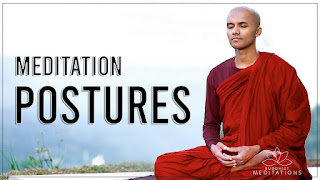"In the sacred stillness of meditation posture, align your body as a vessel for inner peace. Rooted like an ancient tree, let breath flow effortlessly, shaping serenity within. Embrace the silent dialogue between body and soul, where the dance of stillness unveils the profound artistry of self-discovery and mindfulness."
Best Meditation Posture:
- The key to a productive meditation experience lies in the posture you choose, and Swami Rama, in his work "Meditation and its Practice," highlights the essential requirements for a good meditation posture. The posture should have the qualities of stillness, steadiness, rest and relaxation, as any physical movement or discomfort during meditation can prove disturbing. Contrary to a common misconception, complex lotus pose is not a prerequisite for meditation. The primary criterion is that the chosen posture enables alignment of the head, neck and trunk, facilitating unrestricted and diaphragmatic breathing.
- Central to all meditation postures is the need to maintain the alignment of the head and neck, avoiding any twists or turns. The head should rest on the neck, placed directly over the shoulders without creating tension in the neck or shoulders. It is recommended to close the eyes gently, without applying pressure or squeezing them shut. Swami Rama discourages looking up forcefully, as this can strain the eye muscles and possibly lead to headaches. Instead, he emphasizes the importance of relaxing the facial muscles, keeping the mouth gently closed and breathing completely through the nostrils. In meditation posture, it is advised to keep the shoulders and arms relaxed, resting gently on the knees. The arms should be so relaxed that they feel limp if lifted. Swami Rama introduced the “finger lock” mudra, where the thumb and index finger delicately join to form a symbolic circle—a small circuit that represents the recycling of energy within. This mudra, while optional, adds a symbolic dimension to the meditation practice. Overall, Swami Rama's teachings highlight the simplicity and adaptability of meditation postures, emphasizing their role in creating an environment conducive to inner reflection and tranquility.
- In meditation posture, it is advised to keep the shoulders and arms relaxed, resting gently on the knees. The arms should be so relaxed that they feel limp if lifted. Swami Rama introduced the “finger lock” mudra, where the thumb and index finger delicately join to form a symbolic circle—a small circuit that represents the recycling of energy within. This mudra, while optional, adds a symbolic dimension to the meditation practice. Overall, Swami Rama's teachings highlight the simplicity and adaptability of meditation postures, emphasizing their role in creating an environment conducive to inner reflection and tranquility.
- Central to all meditation postures is the need to maintain the alignment of the head and neck, avoiding any twists or turns. The head should rest on the neck, placed directly over the shoulders without creating tension in the neck or shoulders. It is recommended to close the eyes gently, without applying pressure or squeezing them shut. Swami Rama discourages looking up forcefully, as this can strain the eye muscles and possibly lead to headaches. Instead, he emphasizes the importance of relaxing the facial muscles, keeping the mouth gently closed and breathing completely through the nostrils. In meditation posture, it is advised to keep the shoulders and arms relaxed, resting gently on the knees. The arms should be so relaxed that they feel limp if lifted. Swami Rama introduced the “finger lock” mudra, where the thumb and index finger delicately join to form a symbolic circle—a small circuit that represents the recycling of energy within. This mudra, while optional, adds a symbolic dimension to the meditation practice. Overall, Swami Rama's teachings highlight the simplicity and adaptability of meditation postures, emphasizing their role in creating an environment conducive to inner reflection and tranquility.
- In meditation posture, it is advised to keep the shoulders and arms relaxed, resting gently on the knees. The arms should be so relaxed that they feel limp if lifted. Swami Rama introduced the “finger lock” mudra, where the thumb and index finger delicately join to form a symbolic circle—a small circuit that represents the recycling of energy within. This mudra, while optional, adds a symbolic dimension to the meditation practice. Overall, Swami Rama's teachings highlight the simplicity and adaptability of meditation postures, emphasizing their role in creating an environment conducive to inner reflection and tranquility.





No comments:
Post a Comment